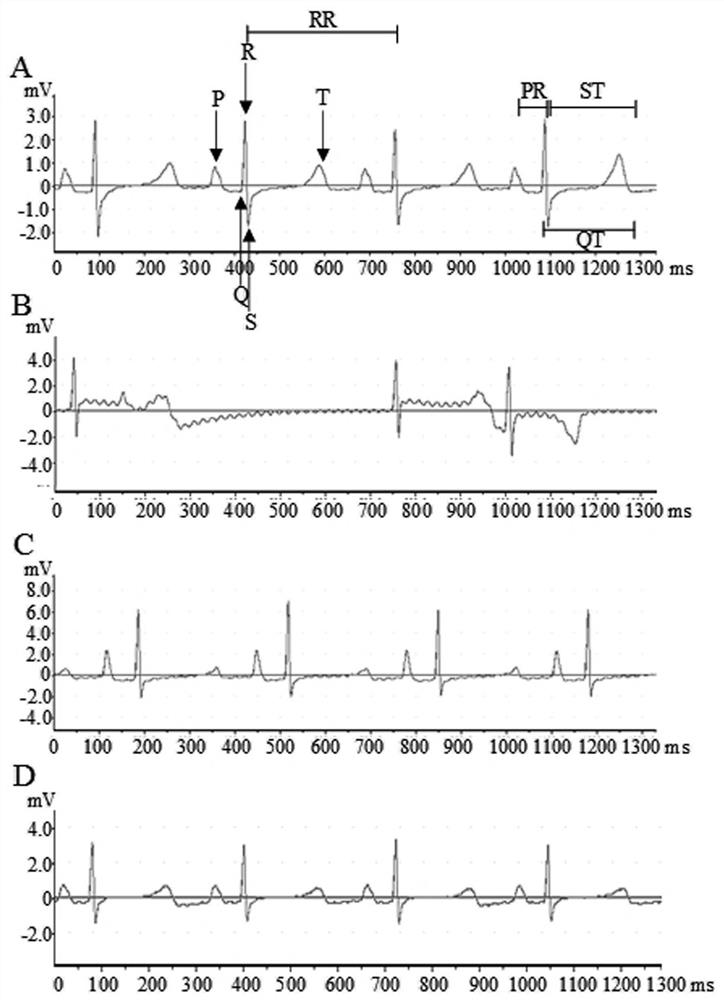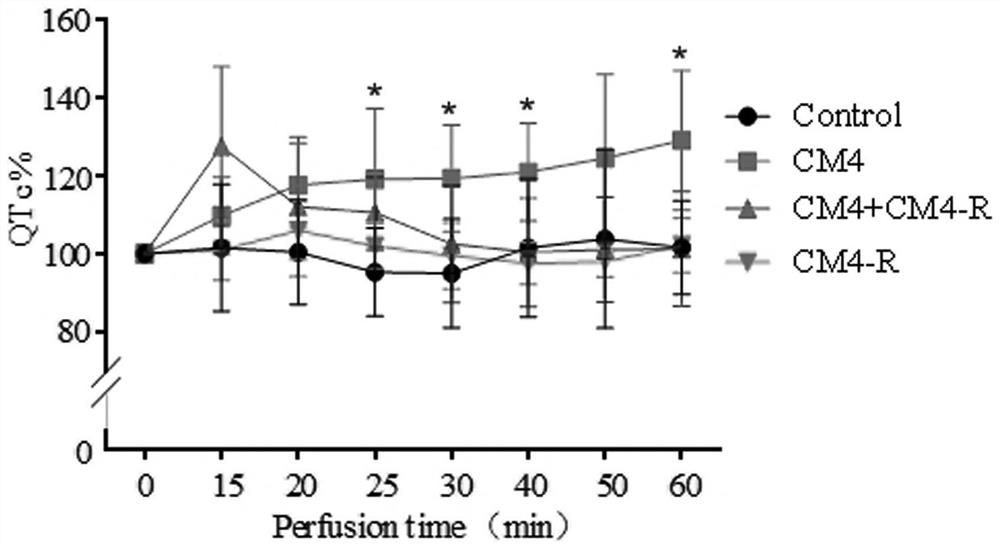Polypeptide CM4-R and application thereof
A CM4-R, application technology, applied in the field of polypeptide CM4-R and its application, can solve problems such as unsatisfactory male effect, and achieve the effect of QT interval prolongation correction and arrhythmia correction
- Summary
- Abstract
- Description
- Claims
- Application Information
AI Technical Summary
Problems solved by technology
Method used
Image
Examples
Embodiment 1
[0034] Example 1 Polypeptide CM4-R was synthesized by solid phase synthesis.
[0035] Peptide CM4-R (Gill Biochemical (Shanghai) Co., Ltd., Lot No: P171026-CQ616455).
[0036] The amino acid sequence of a polypeptide for treating QT prolongation caused by CaM mutation is as follows: CM4-R: GRKKRRQRRRGEVDEMIREADIDGDGQVNYEEFVQMM, MW: 4426.93. The purity of the peptide was detected by HPLC as figure 1 As shown in Table 1, it can be seen from the spectrum that the purity of the polypeptide CM4 is (6937832 / 7675371)×100%=90.39%.
[0037] Table 1. CM4-R HPLC detection related parameters.
[0038]
Embodiment 2
[0039] Embodiment 2 Langendorff perfusion experiment.
[0040] Guinea pigs were injected with heparin (150U / kg / ip) and anesthetized with sodium pentobarbital (40mg / kg / ip). The trachea is connected to an artificial respirator. The aorta was cannulated in situ under artificial respiration. The heart is quickly removed and mounted on a perfusion set. Coronary arteries were retrogradely perfused with Krebs-Henseleit (K-H) solution (5.4mM glucose, 116.0mM NaCl, 3.6mM KCl, 23.0mM NaHCO 3 , 1.16mM KH 2 PO 4 , 1.2mM CaCl 2 , 0.58mM MgSO 4 , 0.3mM pyruvate, and 2.8U·L - 1 insulin), and the heart was kept in a constant temperature room at 37°C. Coronary perfusion pressure was monitored during aortic cannulation and adjusted to a range of approximately 60-70 mmHg. Place the negative pole of the electrode in the right atrium, and the positive pole in the left ventricle (apex), and record the electrocardiogram (QT interval) using a biological experiment system. In this experimen...
Embodiment 3
[0055] Embodiment 3 Whole animal experiment.
[0056] The mice were randomly divided into four groups: (1) Control group: 0.9% NaCl; (2) CM4 group: 21mg / kg CM4; (3) CM4-R group: 21mg / kg CM4-R; (4) CM4+CM4 -R group: 21mg / kg CM4+42mg / kg CM4-R, administered for 3 weeks.
[0057] After 3 weeks, mice in each group were anesthetized with isoflurane (3%, inhalation). In order to determine the effect of CM4 on the QT interval of mice, we first used the biological experiment system (Chengdu Taimeng Software Co., Ltd., Chengdu, China) to detect the ECG, such as Figure 6-7 shown. The two ECG electrodes are placed in the standard lead II direction. Calculate the QT interval. The calculation formula of QTc is: QTc=QT / RR 1 / 2 , see Table 4.
[0058] Table 4 Effects of CM4 and CM4-R on ECG parameters of mouse heart.
[0059]
[0060] Abbreviations: N, number of animals; BW, body weight; HR, heart rate; PR, time from P wave onset to QRS or RS wave onset; QRS, time from Q wave to S w...
PUM
 Login to View More
Login to View More Abstract
Description
Claims
Application Information
 Login to View More
Login to View More - R&D
- Intellectual Property
- Life Sciences
- Materials
- Tech Scout
- Unparalleled Data Quality
- Higher Quality Content
- 60% Fewer Hallucinations
Browse by: Latest US Patents, China's latest patents, Technical Efficacy Thesaurus, Application Domain, Technology Topic, Popular Technical Reports.
© 2025 PatSnap. All rights reserved.Legal|Privacy policy|Modern Slavery Act Transparency Statement|Sitemap|About US| Contact US: help@patsnap.com



